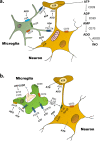Surveilling microglia dampens neuronal activity: operation of a purinergically mediated negative feedback mechanism
- PMID: 33866328
- PMCID: PMC8053197
- DOI: 10.1038/s41392-021-00586-4
Surveilling microglia dampens neuronal activity: operation of a purinergically mediated negative feedback mechanism
Conflict of interest statement
The authors declare no competing interests.
Figures

Comment on
-
Negative feedback control of neuronal activity by microglia.Nature. 2020 Oct;586(7829):417-423. doi: 10.1038/s41586-020-2777-8. Epub 2020 Sep 30. Nature. 2020. PMID: 32999463 Free PMC article.
Similar articles
-
Microglial number is related to the number of tyrosine hydroxylase neurons in SHR and normotensive rats.Auton Neurosci. 2016 Jul;198:10-8. doi: 10.1016/j.autneu.2016.05.005. Epub 2016 May 24. Auton Neurosci. 2016. PMID: 27260963
-
Actin-mediated Microglial Chemotaxis via G-Protein Coupled Purinergic Receptor in Alzheimer's Disease.Neuroscience. 2020 Nov 10;448:325-336. doi: 10.1016/j.neuroscience.2020.09.024. Epub 2020 Sep 14. Neuroscience. 2020. PMID: 32941933 Review.
-
Purinergic signalling mediates the inhibitory effect of microglia on neuronal activity in the brain.Purinergic Signal. 2020 Dec;16(4):477-478. doi: 10.1007/s11302-020-09759-2. Epub 2021 Jan 6. Purinergic Signal. 2020. PMID: 33404957 Free PMC article. No abstract available.
-
Emerging Roles of Microglia in Neuro-vascular Unit: Implications of Microglia-Neurons Interactions.Front Cell Neurosci. 2021 Oct 12;15:706025. doi: 10.3389/fncel.2021.706025. eCollection 2021. Front Cell Neurosci. 2021. PMID: 34712121 Free PMC article.
-
Snapshot of microglial physiological functions.Neurochem Int. 2021 Mar;144:104960. doi: 10.1016/j.neuint.2021.104960. Epub 2021 Jan 15. Neurochem Int. 2021. PMID: 33460721 Review.
Cited by
-
The role of microglia in neuronal and cognitive function during high altitude acclimatization.Sci Rep. 2024 Aug 16;14(1):18981. doi: 10.1038/s41598-024-69694-9. Sci Rep. 2024. PMID: 39152179 Free PMC article.
-
Nanoparticulate matter exposure results in white matter damage and an inflammatory microglial response in an experimental murine model.PLoS One. 2021 Jul 2;16(7):e0253766. doi: 10.1371/journal.pone.0253766. eCollection 2021. PLoS One. 2021. PMID: 34214084 Free PMC article.
-
Microglia dynamics in aging-related neurobehavioral and neuroinflammatory diseases.J Neuroinflammation. 2022 Nov 17;19(1):273. doi: 10.1186/s12974-022-02637-1. J Neuroinflammation. 2022. PMID: 36397116 Free PMC article. Review.
-
P2Y12 receptor gene polymorphisms are associated with epilepsy.Purinergic Signal. 2023 Mar;19(1):155-162. doi: 10.1007/s11302-022-09848-4. Epub 2022 Feb 17. Purinergic Signal. 2023. PMID: 35175489 Free PMC article.
-
New insights in ferroptosis: Potential therapeutic targets for the treatment of ischemic stroke.Front Pharmacol. 2022 Nov 8;13:1020918. doi: 10.3389/fphar.2022.1020918. eCollection 2022. Front Pharmacol. 2022. PMID: 36425577 Free PMC article. Review.
References
Publication types
MeSH terms
LinkOut - more resources
Full Text Sources
Other Literature Sources

